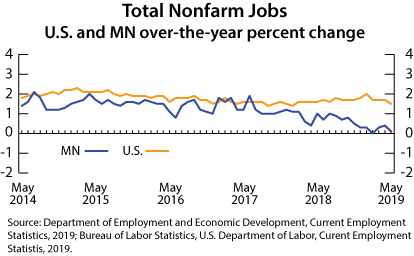by Nick Dobbins
June 2019
Monthly analysis is based on unadjusted employment data.
Employment in the Minneapolis-St. Paul-Bloomington MSA was up by 20,611 (1 percent) in May. While this was the largest proportional over-the-month growth of any MSA that is primarily in Minnesota, it still lagged behind the state’s 1.4 percent employment increase. Every supersector added jobs on the month save three – Educational and Health Services, Other Services, and Government, two of which are highly influenced by school schedules. The largest gains also came in highly seasonal industries like Mining, Logging, and Construction (up 7,955 or 10.1 percent) and Leisure and Hospitality (up 8,846 or 4.8 percent). Annually employment in the metro area was down by 4,442 (0.2 percent), dipping back into negative over-the-year growth after being on the positive side of the ledger for the previous two months. The largest decline, both proportionally and numerically, came in Educational and Health Services, which was down 6,889 jobs or 2 percent, with declines in both of its major components. Mining, Logging, and Construction had the largest employment increase, both proportionally and in real jobs, adding 3,032 or 3.6 percent. After dipping into negative over-the-year growth in February, the supersector has shown annual gains of 2.4, 5.1, and 3.6 percent in the past three months, suggesting a strong early start to the summer construction season.
The Duluth-Superior MSA added 1,116 jobs (0.8 percent) in May. Seasonal losses in Government (down 173 or 0.6 percent) and Educational and Health Services (down 398 or 1.2 percent) were more than offset by increases in their warm-weather counterparts Leisure and Hospitality (up 959 or 6.8 percent) and Mining, Logging, and Construction (up 493, 5.3 percent). Over the year the Duluth area lost 765 jobs (0.8 percent). This was the second largest proportional over-the-year job loss of any MSA in the state, trailing only Grand Forks-East Grand Forks, which is primarily in North Dakota. Declines in Retail Trade employment (down 1,200 jobs or 7.8 percent), which contributed to a loss of 1,182 (4.7 percent) in the Trade, Transportation, and Utilities supersector, drove the negative growth, although the steepest proportional declines came in the small Information supersector, where employment was down by 5.2 percent or 69 jobs. Mining, Logging, and Construction had the largest real and proportional growth, adding 466 jobs or 5 percent.
The Rochester MSA added 943 jobs (0.8 percent) in May. Mining, Logging, and Construction added 409 jobs (8.8 percent), and Leisure and Hospitality added 444 (3.9 percent) as is to be expected in the spring. Over the year the Rochester area added 1,389 jobs (1.1 percent), widely outpacing the state’s 0.1 percent growth. Educational and Health Services added 516 jobs (1 percent), and Leisure and Hospitality added 458 (4 percent).
The Saint Cloud MSA added 453 jobs (0.4 percent) in May. Mining, Logging, and Construction drove the growth, adding 614 jobs or 8.5 percent. The largest real and proportional decline came in Government, which lost 290 jobs or 1.8 percent. Annually the area added 1,715 jobs or 1.6 percent. This was the largest over-the-year job increase of any MSA in the state. Mining, Logging, and Construction did most of the work, adding 1,082 jobs (16 percent) on the year, far outpacing the growth from any other supersector. Educational and Health Services added 710 jobs or 3.2 percent. Trade, Transportation, and Utilities lost 524 jobs (2.3 percent), with all of those declines coming in Retail Trade (off by 641 or 4.7 percent).
The Mankato-North Mankato MSA lost 51 jobs or 0.1 percent in May. It was the only MSA in the state to lose jobs on the month. Goods producers added 277 jobs (2.7 percent), but that wasn’t enough to overcome the loss of 328 jobs (0.7 percent) among service providers. Annually employment in the Mankato-North Mankato MSA was up by 157 (0.3 percent). Government employers added 121 of those jobs (up by 1.2 percent), and the private sector chipped in 36 (up 0.1 percent). Both goods producers and service providers had positive annual job growth.
The Fargo-Moorhead MSA added 2,535 jobs or 1.8 percent in May. This was the largest proportional over-the-month job growth of any reported MSA in Minnesota. The area’s growth came with strong months from Mining, Logging, and Construction (up 1,354 or 18.2 percent) and Professional and Business Services (up 766, 4.9 percent), among other supersectors. Annually the MSA added 489 jobs (0.3 percent). The growth came despite the loss of 802 jobs (2.6 percent) in Trade, Transportation, and Utilities and the loss of 1,040 jobs (6.6 percent) in Retail Trade. The largest over-the-year growth was in Professional and Business Services, up by 536 or 3.4 percent.
The Grand Forks-East Grand Forks MSA added 477 jobs or 0.9 percent in May. Mining, Logging, and Construction added 397 jobs (15.2 percent). Leisure and Hospitality added just 45 jobs (0.8 percent). It was the only reported MSA in Minnesota to have less than 1 percent growth in the supersector and lagged well behind the state’s 5.8 percent overall growth. The Grand Forks-East Grand Forks MSA lost 536 jobs or 1 percent on the year. It was the single largest proportional over-the-year job loss of any reported MSA in Minnesota. Trade, Transportation, and Utilities employers lost 610 jobs (5.4 percent) primarily from the loss of 587 jobs (8 percent) from the Retail Trade component sector.
